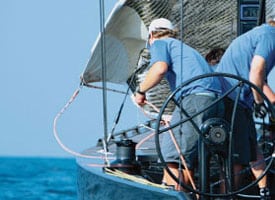
Good Tacks 368
A decade ago in Key West I was on Vim III, a custom IMS racer, tailing the genoa through the tacks. Ed Reynolds, a founding partner in Quantum Sails, was in charge of releasing. He was in the midst of writing for this magazine an article on how to release the genoa, so he spent a lot of time thinking and talking about how to do it properly. In fact, he spent so much energy pondering his technique he had a hard time actually doing it. Of course, the rest of us on the boat gave him endless grief about his struggles. Fortunately, we had a good regatta on a very fast boat and won our class.
When I was asked to provide an updated look at releasing the jib, I considered Ed’s experience. After all I was just weeks away from heading to Key West on a Melges 32. Since I wasn’t slated to be releasing the jib, however, I figured I was in the clear.
The common element that connects all good racing maneuvers is spending as much time as possible at full speed. In many competitive classes, all of the good boats can sail close to their potential much of the time. One place where boats can pick up time is in the turns. Because they seem simple, tacks are often overlooked in favor of sets, jibes, and douses. However, the average raceboat will do more tacks than any of those other maneuvers during an average race, often by a factor of two or more. Improving your tacks by 2 or 3 seconds can save you 30 or 40 seconds around the racecourse, and in a tight one-design or handicap fleet, that much time can be the difference between finishing in the top three or the bottom three.

Meghan Sepe/www.meghansepe.com| |The forward hand is ready to take off the final wraps while the back hand is there to let the sheet run through. Look forward to watch the rate of turn and the backwinding of the luff. The release will depend on the conditions.|
“Releasing the jib may seem the easiest part of a tack. However, just because it doesn’t require the same strength as grinding or tailing doesn’t mean it should be dismissed. The release is one of the most important parts of the tack. A good release makes the rest of the mechanics of the tack easier, from tailing and grinding to turning the boat. It is commonly overlooked by teams placing a premium on the tailing and grinding. When a tack doesn’t go well, one of the first places to look is the release.
One of the biggest ways to make tacks faster is by minimizing the flapping of the sail, which creates a tremendous amount of drag. An early release, which allows the clew to move away from the centerline and the sail to flap as the bow passes through the wind, is very slow. Holding the release to get the correct amount of back wind in the headsail is the way to a good tack. A proper back allows the sail to blow smoothly through the foretriangle, which makes it easier to tail on the new tack. It will also help the helmsman steer through the tack efficiently, and allow them to quickly find the correct exit angle on the new tack. The ideal tack is one during which the sail never actually flaps, it just goes from full on the old tack to full on the new tack. It may sound difficult, but it can be achieved with proper timing and technique.

Meghan Sepe/www.meghansepe.com| |Spin the wraps off the drum as you pull it upwards with your front hand, and allow the sheet to pay out through your back hand. Keep an eye on the sail and the sheet to make sure it does not get hung up anywher|
On a medium sized boat, 35 to 45 feet, I like to use three people to tack the sail: one to release the old sheet, one to tail the new sheet, and one to grind and do the final trim. When a tack is called, the releaser is the first one off the rail. He or she goes to leeward, uncleats the jib sheet, and unwinds a few wraps off the winch, being careful not to let the sheet slip. There should just enough wraps left on the winch to hold the sheet. As the boat turns into the tack, the releaser watches the bow of the boat and the luff of the jib. As the luff starts to backwind, an ease of about 3 to 4 inches will help the boat turn and take a bit of the load off the sheet. Once the jib is backwinded about halfway to the mast, release the sail completely by taking off all wraps. On this size boat you can usually lift the sheet vertically and pull all of the wraps off the winch. If it’s windy and you’re tacking a genoa, you may need to make the release a bit more controlled by taking the wraps off and letting the sheet run through your hand.
The job isn’t finished once the sheet is stripped from the winch. A stiff jib sheet is likely to come off the winch with kinks, which can easily bind in the blocks. So the crew that’s releasing needs to watch the sheet pay out, ensuring it doesn’t get hung up, then jump on the windward rail and hike as the boat accelerates on the new tack. In the meantime, the tailer will be pulling sheet-speed and timing are more important than strength here-and sliding his weight towards the windward side. Some people try to tail the jib from the new windward rail but it’s better to tail from the windward edge of the cockpit where there’s better footing and a better angle, allowing the tailer to snap in the jib properly. The trimmer is the grinder in this scenario. He will grind the sheet and then take the tail from the tailer once he’s close to final trim. The trimmer/grinder can make final adjustments on his own with everyone else on the rail, hiking hard.
A lot of practice has to go into good tacks and releases. The mechanical part of the release is not very hard. The timing, on the other hand, is. If the sail is released too early, it will flap as the bow goes through the wind-bad for the sail and for the boatspeed. If the release is too late then the backed sail will drag the bow too low on the new tack and the jib will end up too far out, resulting in a lot of work to get the sail trimmed in and the boat back up to speed.
In light air, release the jib later, allowing it to back wind a little more and help turn the boat onto the new tack. As the wind increases, the release must be earlier so that the bow does not get blown through the wind too fast. It requires constant adjustment. A good dialogue between the helmsman and the releaser is very important. The helmsman can feel and see the amount of back wind in the jib very easily and must communicate to the trimming team what he wants. If the helmsman needs a lot of rudder to tack the boat, the release may need to be a delayed in order to help the turn. If, after the tack, it takes a lot of work to get the bow up to the proper upwind angle, the jib is being released too late. Practicing this timing before an event, and even before each race, is time well spent because your timing may change a result of a different sea state or physical being (it’s the last race of the day and everyone’s getting tired). One of the great things about sailing is that the playing field is always changing, so you need to continually adjust the release and the tack.
During races it is common for the best helmsmen to have a running dialog with the person releasing the jib so that the helmsman’s feeling of the tack can help the timing of the release. As the helmsman changes the rate of turn for the given conditions, sea state and wind variations, then the releaser must change the timing of the release. The common cue is how far back from the headstay that you see the back wind on the sail. The position that you and your team has determined to be the best time for the release will remain constant. What changes is the amount of time it takes the sail to get there. So you don’t want to try and release based on a countdown, it has to be felt as the boat flattens out, and it has to be visual. The timing of the release from the start of the tack will always be a little different based on the speed of the turn.
You’ll notice that I haven’t bothered to differentiate between an overlapping genoa and the 100-percent jibs common on modern one-designs like the Farr 40. The timing of the release isn’t drastically different. Releasing a genoa too early causes it to get hung up on the spreaders and mast and flap around. Releasing a jib too early can cause the battens to get hung up on the mast and flap around. Likewise with a jib; a late release on the genoa will drag the bow down after the tack and make the grinder and tailer work extra hard to get the sail in. If there is one difference, it’s that a late release on a genoa can cause the spreader to punch a hole in the sail, something you don’t have to worry about with a non-overlapping headsail.
However, if you’ve spent a lot of time tacking an overlapping sail, don’t get caught thinking that because the jib is smaller, that tacking it is easy and the timing is less important. Both types of sails use the same principles and similar timing. Practice and feedback from the helmsperson and trimmer will make the biggest impact in the performance of the release. Shaving those few seconds off the time spent downspeed will turn into incremental gains around the racecourse.









